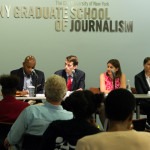By Rebecca Baker
Controversy over cartoons depicting the Prophet Muhammad sparked impassioned discussion at The Deadline Club’s spring free speech panel, framing a debate that again made headlines a few weeks later when two gunmen targeted an anti-Islam art exhibit in Texas on May 3, and were shot dead.
The club’s March 29 event, called “Limits of Free Speech: Publishing in a Hacked and Charlie Hebdo World,” brought together a renowned imam, a media lawyer and two well-known “free speech absolutists” at the CUNY Graduate School of Journalism to debate rights versus responsibility in publishing inflammatory images and other contested content.
Responding to charges that news outlets are weak-kneed for refusing to re-publish the Charlie Hebdo cartoons, panelists parried over how to balance internal and external pressures in deciding what to publish about events that may endanger media workers.
Signe Wilkinson, a Pulitzer Prize-winning editorial cartoonist for the Philadelphia Daily News, criticized newspapers that declined to publish Charlie Hebdo’s images, calling it a “great show of cowardice.”
“It was a news story,” she said. “This is what cartoonists do. They poke you in the eye and people are immediately outraged. … The cartoon is not the end of a conversation. It’s the start of a conversation.”
But Gail Gove, chief counsel of news for Reuters, countered that accusing media outlets of cowardice for withholding inflammatory images “is gravely wrong.” She said the first question Reuters’ editors ask before publishing images and words is, “Who could die?”
“I don’t think it’s fair,” said Gove, also an adjunct professor of media law and ethics at the CUNY journalism school. “It’s really hard analysis. Unless you’re in the room, I don’t think it’s fair to judge it.”
The Jan. 7 terrorist attack on the Paris office of Charlie Hebdo left 12 dead, including many of the cartoonists who drew satirical images of Muhammad.
“You have to think about the consequences,” Gove said. “Sometimes the most heroic thing you can do as a news organization is not publish. Sometimes it’s our own ego, and we want to stand on principle—we’re going to show the world how bad this was—but if we do it, we’re going to be hurting other people.”
Victor Navasky, publisher emeritus of The Nation and author of “The Art of Controversy: Political Cartoons and Their Enduring Power,” called himself a “free speech absolutist,” but described facing personal constraints in publishing cartoons depicting Muhammad.
In his book on the history of provocative cartoons, he said he chose not to reprint any of the dozen images of Muhammad that appeared in a Danish newspaper in 2005 because his publisher worried that it could jeopardize the lives of booksellers. “There were people killed all over the world because of those cartoons,” he said, referring to the 12 images published by Jyllands-Posten that sparked riots globally, resulting in more than 200 deaths and a boycott of Danish goods.
“It’s an act of judgment of taste and social responsibility sometimes not to publish these things,” added Navasky, a professor at the Columbia Journalism School and chair of the Columbia Journalism Review. “You have to talk about free speech in terms of responsibility.”
Imam Feisal Abdul Rauf, founder of the multi-faith Cordoba Initiative and of the American Society for Muslim Advancement, who is known for his advocacy for the “Ground Zero mosque,” said “most moderate Muslims really don’t care” about Muhammad’s portrayal in cartoons. The Charlie Hebdo murders, he said, “were not called for under any aspect of Islamic law or Islamic practice.”
“The Quran is quite specific in saying, ‘Respond to an evil with a kindness’ so that the person who has wronged you is transformed into a friend,” he said. “Best of all, it is to forgive the person who has wronged you.”
However, Rauf discouraged journalists from “mocking” the faith of others in the name of free speech, especially those who are already marginalized in society and for whom faith is tied to honor.
There are some parts of the world, he said, where “losing your honor is worse than losing your life. And you would lose your life just to preserve your honor. The idea of insulting a group of people, in some parts of the world they would rather die—die as a martyr.”
David Wallis, deputy editor of The New York Observer, said journalists, including editorial cartoonists, should consistently “punch up at the mob mentality” that insists on censoring images. “I wonder if some of the mocking that your religion has undergone is part of the Americanization of Muslim Americans,” he said. “Every religion takes their hits in American society.”
Wallis, the author of “Killed Cartoons: Casualties from the War on Free Expression,” reminded that media layoffs have resulted in far fewer editorial cartoonists at U.S. newspapers today, and challenged the Herb Block Foundation to endow a full-time cartoonist at a newspaper for 20 years.
On a lighter note, he made a similar challenge to The Huffington Post founder Arianna Huffington. “She could afford to endow two,” he said. “It’s time for her to pay the piper.”
At the panel, moderated by Deadline Club events chair Jessica Seigel six weeks before the attempted shooting attack on the Texas art exhibit, Wilkinson noted that there was “no physical retribution” against any of the U.S. news organizations that published or aired the Hebdo cartoons. Cartoons provoke outcry, she said, when they criticize religious groups, which brings important issues into the open.
“Cartoons don’t kill people. Humorless religious fanatics do,” she said. “If you don’t want your prophet depicted in a nasty cartoon, don’t do nasty things in the name of your prophet.”








